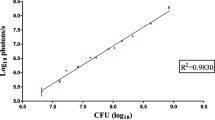Abstract
A recombinant DNA, pMG36e::luc+ (5.3 kb), was constructed and transferred to Escherichia coli MC1061 and Lactococcus lactis MG1363 for in vivo imaging of the bacteria in murine intestines. E. coli MC1061 (pMG36e::luc+) and L. lactis MG1363 (pMG36e::luc+) displayed luciferase activities in vitro, where the bioluminescent signal of the E. coli was much stronger than that of the L. lactis by approximately 100-fold. These 2 recombinant bacteria were orally administered into rats. The bioluminescent signals of the E. coli and L. lactis in the gastrointestinal (GI) tracts of rats were detected and maintained up to 2 h via whole body imaging, indicating that the luciferase gene expression system for bacteria could be applied for in vivo imaging.
Similar content being viewed by others
References
Culligan EP, Hill C, Sleator RD. Probiotics and gastrointestinal disease: Successes, problems, and future prospects. Gut Pathog. 1: 19 (2009)
Narayan SS, Jalgaonkar S, Shahani S, Kulkarni VN. Probiotics: Current trends in the treatment of diarrhoea. Hong Kong Med. J. 16: 213–218 (2010)
Chmielewska A, Szajewska H. Systematic review of randomised controlled trials: Probiotics for functional constipation. World J. Gastroentero. 16: 69–75 (2010)
Forsythe P, Bienenstock J. Immunomodulation by commensal and probiotic bacteria. Immunol. Invest. 39: 429–448 (2010)
Gobbetti M, Cagno RD, De Angelis M. Functional microorganisms for functional food quality. Crit. Rev. Food Sci. 50: 716–727 (2010)
de Moreno de Leblanc A, Perdigón G. The application of probiotic fermented milks in cancer and intestinal inflammation. P. Nutr. Soc. 69: 421–428 (2010)
Iannitti T, Palmieri B. Therapeutic use of probiotic formulations in clinical practice. Clin. Nutr. 29: 701–725 (2010)
Bezkorovainy A. Probiotics: Determinants of survival and growth in the gut. Am. J. Clin. Nutr. 73(suppl.): 399S–405S (2001)
Dunne C, O’Mahony L, Murphy L, Thornton G, Morrissey D, O’Halloran S, Feeney M, Flynn S, Fitzgerald G, Daly C, Kiely B, O’sullivan GC, Shanahan F, Collins JK. In vitro selection criteria for probiotic bacteria of human origin: Correlation with in vivo findings. Am. J. Clin. Nutr. 73(suppl.):386S–392S (2001)
Cronin M, Sleator RD, Hill C, Fitzgerald GF, van Sinderen D. Development of a luciferase-based reporter system to monitor Bifidobacterium breve UCC2003 persistance in mice. BMC Microbiol. 8: 161 (2008)
Schultz M, Watzl S, Oelschlaeger TA, Rath HC, Göttl C, Lehn N, Schölmerich J, Linde HJ. Green fluorescent protein for detection of the probiotic microorganism Escherichia coli strain Nissle 1917 (EcN) in vivo. J. Microbiol. Methods 61: 389–398 (2005)
Chudakov DM, Matz MV, Lukyanov S, Lukyanov KA. Fluorescent proteins and their applications in imaging living cells and tissues. Physiol. Rev. 90: 1103–1163 (2010)
Prescher JA, Contag CH. Guided by the light: Visualizing biomolecular processes in living animals with bioluminescence. Curr. Opin. Chem. Biol. 14: 80–89 (2010)
Min JJ, Nguyen VH, Kim HJ, Hong Y, Choy HE. Quantitative bioluminescence imaging of tumor-targeting bacteria in living animals. Nat. Protoc. 3: 629–636 (2008)
de Palencia PF, de la Plaza M, Mohedano ML, Martínez-Cuesta MC, Requena T, López P, Peláez C. Enhancement of 2-methylbutanal formation in cheese by using a fluorescently tagged lacticin 3147 producing Lactococcus lactis strain. Int. J. Food Microbiol. 93: 335–347 (2004)
Geoffroy MC, Guyard C, Quatannens B, Pavan S, Lange M, Mercenier A. Use of green fluorescent protein to tag lactic acid bacterium strains under development as live vaccine vectors. Appl. Environ. Microb. 66: 383–391 (2000)
Gory L, Montel MC, Zagorec M. Use of green fluorescent protein to monitor Lactobacillus sakei in fermented meat products. FEMS Microbiol. Lett. 194: 127–133 (2001)
Oddone GM, Lan CQ, Rawsthorne H, Mills DA, Block DE. Optimization of fed-batch production of the model recombinant protein GFP in Lactococcus lactis. Biotechnol. Bioeng. 96: 1127–1138 (2006)
van de Guchte M, van der Vossen JMBM, Kok J, Venema G. Construction of a Lactococcal expression vector: Expression of hen egg white lysozyme in Lactococcus lactis subsp. lactis. Appl. Environ. Microb. 55: 224–228 (1989)
Moon GS, Lee YD, Kim WJ. Screening of a novel lactobacilli replicon from plasmids of Lactobacillus reuteri KCTC 3678. Food Sci. Biotechnol. 17: 438–441 (2008)
Lee MS, Kwon EH, Choi HS, Kwon SH, Lee CH, Shim IS, Lee SK, Her S. Quantification of cellular uptake and in vivo tracking of transduction using real-time monitoring. Biochem. Bioph. Res. Co. 394: 348–353 (2010)
Author information
Authors and Affiliations
Corresponding author
Rights and permissions
About this article
Cite this article
Lee, MS., Moon, GS. In vivo imaging of Escherichia coli and Lactococcus lactis in murine intestines using a reporter luciferase gene. Food Sci Biotechnol 21, 917–920 (2012). https://doi.org/10.1007/s10068-012-0120-3
Received:
Revised:
Accepted:
Published:
Issue Date:
DOI: https://doi.org/10.1007/s10068-012-0120-3




